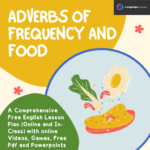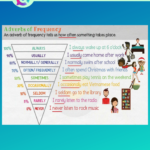Talking Football – Adverbs of Frequency. Free PDF to download. Practice making sentences with adverbs of frequency and other frequency words.
Talking Football – Adverbs of Frequency


Skills to practice:
Practice making sentences with adverbs of frequency and other frequency words.
Class Levels: suitable for elementary and pre-intermediate levels.
Requirements: Cut out the game resources below. Cut out the balls or players and use as markers.
How to play:
- Use the cue words on the sides in the orange rectangles to make sentences with the key words at the center. For example: everyday + brush teeth = I brush my teeth everyday. If the key words at the centre have a question sign on them, then they are expected to ask a question. In this case the cue + key words could be How often +
sleep in front of the TV ? = How often do you sleep in front of the TV? - Players are free to use any of the cue words at the side, but they cannot use one particular cue word twice in a row.
- The two teams or players would toss a coin to decide who starts first, or do Rocks, Paper and Scissors. The winner starts combining a cue word and a key word to make sentences.
- The other team or player must listen carefully to spot the mistakes. If there isn·t any mistake in the sentence, the player can keep his/her space.
- If there is a mistake the team or player gets a yellow card and move back one step. If no mistake they keep their captured space. The other team takes its turn to combine cue words and keys words to make sentences. Every successful sentence means they retain the space and prepare to advance.
- Both teams (players) keep advancing until they meet on one space. When they meet they do ROCKS, PAPER and SCISSORS. The team that looses the ROCKS, PAPER & SCISSORS guess, gets a red card and goes back to start. The winning side continues until they meet again. Every time they, meet they do rocks, paper, and scissors to see who gets a red card. The team that first gets to the other team·s goal, wins.
- When players get to the centre, it is a FREE space so they can create any sentence using adverbs of frequency.
- If you decide to continue, try different key words or swap sides after the first side wins.
- Feel free to adapt this game for your classes as you like. Also feel free to modify or add rules.
Tips for large classes:
This game is a board game, but can also be played in a large class. Photocopy the game on an A3 or larger paper size, or project in on a projector if your class has one. Use blue tag to stick
team players as they advanced.


WE DO NOT SUPPORT COPYRIGHT DISPUTES – USE ONLY FOR TEACHING AND LEARNING PURPOSES



